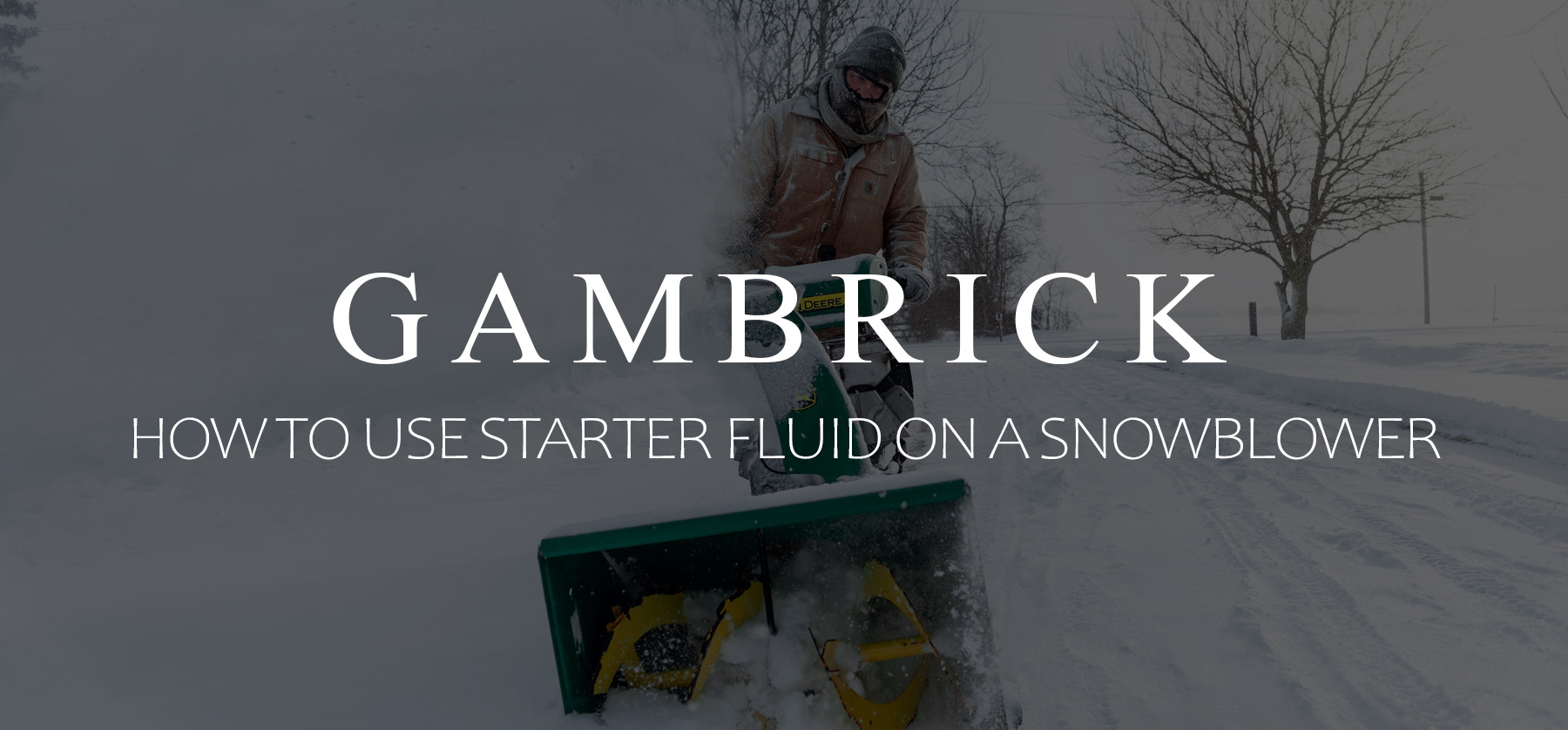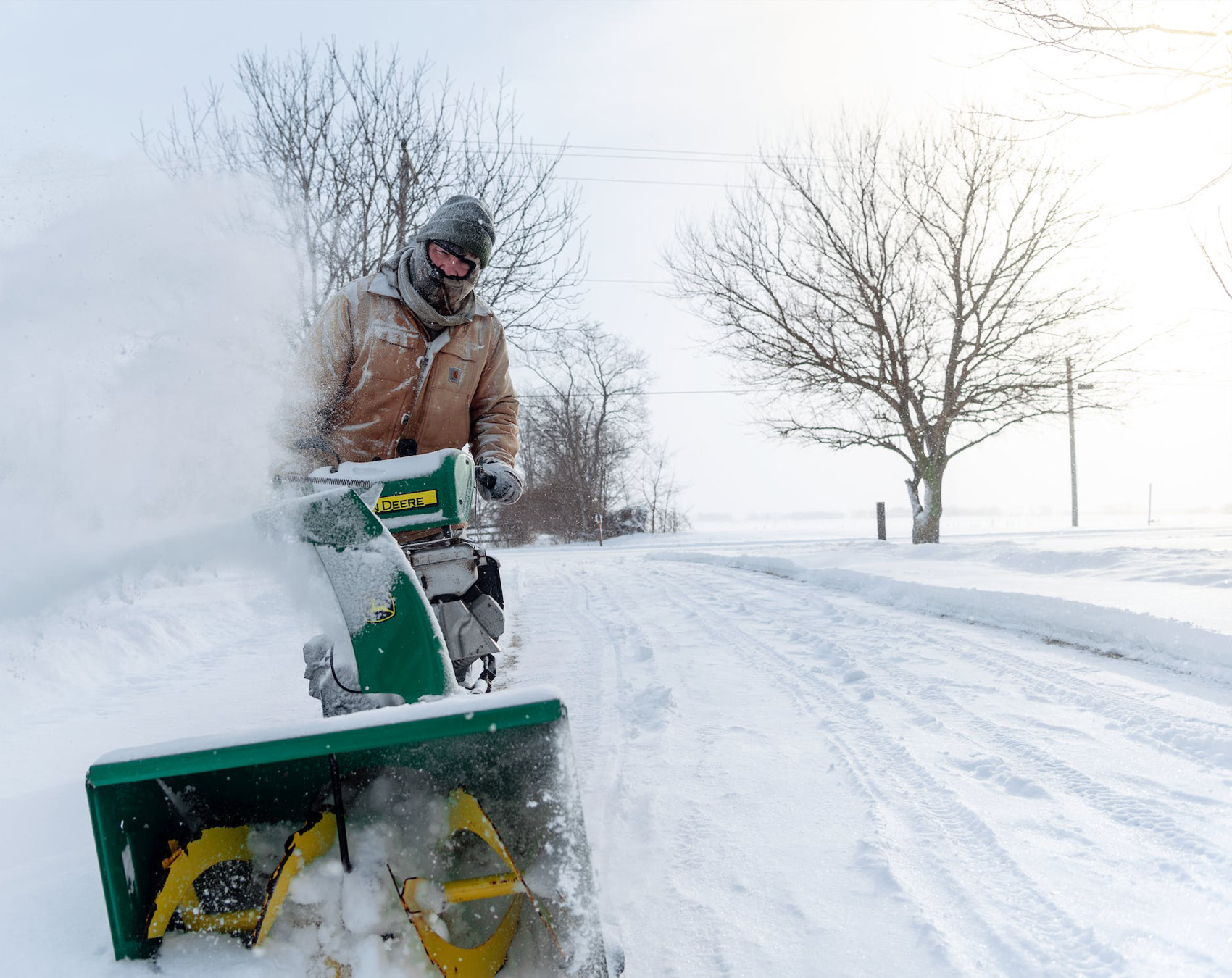How To Use Starter Fluid On A Snowblower
Engine starter fluid is a flammable liquid that’s used to help an internal combustion engine start, especially during freezing cold weather, or when the engine is older or poorly maintained. Starting fluid is highly flammable and combustible, so store and handle it safely. Don’t place the can on a hot engine or spray it near high heat. To use starter fluid on a snowblower, locate the engine’s air intake. Aim the can and spray a short 2 second burst of fluid directly into the intake. Try to start the engine. If it doesn’t start, wait a few seconds, spray a few more bursts of fluid and try again. Repeat no more than 3 to 4 times or you’ll risk flooding the engine.
Unlike a car or lawnmower engine, snowblowers usually don’t have an air filter. The air intake is typically located under a plastic cover near the choke lever. To fully access the carburetor air intake, it may be necessary to take off the plastic cover.
Spray a small burst of starting fluid into the air intake. Keep the can of starting fluid upright as you spray. Aim the can’s nozzle into the air intake from about 12 inches (20 centimeters) away. Spray starting fluid in a short 2 second burst, then try to start the engine.
Don’t spray fluid as you try to turn the engine over. Instead, spray fluid into the air intake, then start the engine. If it doesn’t start, spray a few more bursts, then try to crank the motor again.
Starter fluid is sold in an aerosol spray can and may contain volatile hydrocarbons such as heptane, diethyl ether, carbon dioxide, butane or propane as both propellant and starting fuel. It’s highly flammable, so handle and store it safely.
How & When To Use Starter Fluid On A Snowblower
Starting fluid is a highly combustible liquid that can help an internal combustion engine start up when it’s extremely cold outside, or when the engine is older or poorly maintained. It’s more explosive than gasoline so it ignites easier from a spark and generates more force to crank the engine. When used properly, the extra power generated from start fluid can get a hard-started engine cranking when it normally wouldn’t.
Because starting fluid is highly combustible and quite powerful, you must use it as directed or risk damaging the engine. A short 2 second burst directly into the engine’s air intake is all you need.
I use starting fluid as a last resort to start my snowblowers at the beginning of every season. Before using it, troubleshoot the following reasons why a snowblower doesn’t start:
- Spark plug not working or the timing is off
- Bad fuel
- Carburetor not working properly
- Engine oil
- Make sure the engine turns over
- Problem with the choke.
If you check and tune-up your snowblower engine, change the fluids and add new gas but it still won’t start, it’s time to try some starter fluid.
When it’s freezing cold outside, I recommend starting the snowblower someplace warm like a shed or garage with a space heater. This is especially helpful if it’s the first start of the season which is usually the hardest.
Here’s how to start a snowblower with starter fluid step by step:
Step 1. Remove The Snowblower Engine Cover
Most snowblowers don’t have an air filter like a car or lawn mower does. This makes it a little harder to spray starter fluid into the engine. On a snowblower engine, the air intake is usually located under a protective engine cover. In order to use start fluid, you first have to expose the air intake by removing the cover.
Here’s how to reveal the air intake on a snowblower:
- Locate the choke lever on your snowblower. The choke lever controls the carburetor’s air intake so it should be right next to the carburetor.
- If the engine cover extends over the choke lever, remove any nuts, bolts or screws that hold it in place.
- You may have to remove the choke lever handle itself if it’s in the way.
- Once the engine cover is removed you should see the air carburetor and air intake.
Some snowblowers have a single engine cover and some have multiple covers. You don’t need to remove them all if they’re not in the way of the air intake. Only remove covers that block access to the carburetor and air intake.
If there’s a cable or kill-switch wire attached to the cover, they do not have to be removed.
I have several different snowblower models that we use to remove snow each season. My Husqvarna air intake is very easy to get to so I don’t have to do much prep work to use starting fluid, but my Toro has a lot of covers in the way. Depending on the manufacturer and model snowblower you have, this could be a quick job or it could take some time.
If your snowblower has lots of fasteners, it may be helpful to label them in small baggies.
Step 2. Find The Carburetor
Once the engine cover is removed, the carburetor and air intake should be visible. Look for a piece of metal or a tube with an opening that leads into the carburetor. This is the air intake and the opening is designed to draw fresh air into the engine.
If you need help finding the intake, follow the linkage from the choke lever to the carburetor. The choke lever control how much air is allowed into the carburetor. Follow the lever linkage to the carburetor and nearby will be the intake.
- Locate the carburetor. It’s typically bolted directly on top of the engine.
- The choke is connected to the carburetor.
- The choke lever is connected to the choke by a linkage wire.
- The air intake is a piece of metal or a tube with an open end that’s connected to the carburetor.
- The opening of the air intake will be round, square or rectangular.
- Finding the carburetor or the choke will help you locate the air intake.
On most snowblower engines, the carburetor is bolted directly on top of the engine. The choke is bolted to the side of the carburetor and the air intake is on top or to the side of the carburetor. These parts are always close together because they control the air and fuel mix flowing into the engine.
Step 3. Open The Air Intake Valve
Before spraying starter fluid into the air intake, you should open the air intake valve. To do it, move the choke lever to the open position. If you’re not sure which direction is open, most choke covers have a diagram with a triangle that goes from narrow to wide. Move the choke lever to the “Wide” part of the triangle. This opens the choke which allows air and starter fluid into the carburetor.
- Move the choke lever to the “Open” position.
- The choke cover should have a diagram showing which direction the “Open” position is.
- If you look down the air intake you can sometimes see if the intake valve is open or closed.
- Opening the choke lets more air and starter fluid into the engine.
Taking a picture of the choke diagram with your phone can help you remember which direction is “Open” and which is “Closed”. Don’t try to start the engine with the choke closed. A closed choke will restrict airflow and starter fluid from entering the engine.
Step 4. Spray Starter Fluid Into The Air Intake
Once you’ve opened the choke, spray starter fluid in a short 2 second burst directly into the air intake. This is enough starter fluid to give a serious power boost to the engine when you try to start it. If the engine still doesn’t start, try 2 x 2 second bursts into the intake and crank the engine again. Repeat the process 3 to 4 times until the engine turns over.
- Spray this starter fluid directly into the air intake with the choke wide open.
- Spray in short 2 second bursts.
- Try i burst at first, then try 2 if the engine still doesn’t start.
The air intake funnels air into the carburetor which controls the fuel air mixture used by the engine to create power. Starter fluid is more explosive than gasoline so it creates more power when you crank the engine.
The starter fluid you sprayed into the air intake will enter the carburetor and then the engine when you crank the motor. Starter fluid is an extremely flammable liquid that creates more power when the engine cranks than fuel which helps crank a hard-starting motor.
When used correctly, starter fluid won’t harm a snowblower’s engine. But don’t use too much at a time or you could damage the motor.
Step 5. Start Your Snow Blower
Now, that you’ve opened the choke and sprayed starter fluid into the air intake, it’s time to start your snowblower. If your snowblower engine needs priming, do it now. However, be careful not to over-prime the engine or you could flood the carburetor. If your snowblower has an electric start, use it instead of the pull start. But if your engine is pull start only, make sure to pull as fast and hard as you can.
- Prime the engine before starting if your snowblower has the option to do so.
- Don’t over-prime the engine or you could flood the carburetor.
- If you already primed your snowblower in a previous attempt to start it, don’t prime is again.
- Make sure the choke is in the open position when you try to start your snow blower.
- Adjust the choke after the engine starts. I push mine to medium open.
- Make sure nothing gets sucked into the air intake.
- Use electric start over the pull chain if your snowblower has both.
- If your snowblower has a pull start, pull as fast and hard as you can.
Starter fluid is a very powerful liquid that can typically start a snowblower engine in the first few attempts. But if it doesn’t work, there’s likely a mechanical issue with the engine. Troubleshoot the problem by checking the spark, carburetor, timing and fuel first. What a snowblower engine needs most to start are good fuel, air, spark and proper timing.
Once the engine starts, let it run for a few minutes before blowing snow or turning the engine off. This gets the motor oil flowing and clears out any gunk built up in the engine from sitting idle.
Step 6. Put The Engine Cover Back On
Once you get the engine started, reverse the steps you took to remove the engine and/or choke cover. Bolt or screw the covers back onto the snowblower on the same way you took them off. Then, re-attach any knobs or levers you had to remove. Most snowblower engines are very simple to work on, but if you have trouble remembering where everything goes, take a few pics with your cell phone for reference. This is a helpful tip I use when working on more complicated engines.
- Install the engine covers after the engine is started.
- Don’t put the engine covers on until the engine is running because it may not start on the first attempt.
- Make sure you install the screws/nuts and bolts in the correct places.
If it’s difficult to put the engine cover back on while the snowblower is running, turn it off and then re-install the cover. However, let the motor warm up before you do. It’ll be much easier to start up again if it’s warm.
The reason I never put the engine cover on until I know the snowblower will start is because starter fluid doesn’t always work the first time. Some of my older snowblowers need 3 or 4 attempts before they turn over the first cold start of Winter.
When Should You Use Starter Fluid On A Snowblower?
Start fluid should be used to start a hard-starting snowblower as a last resort. It’s highly flammable and combustible which can put undo strain on an engine. If your snowblower won’t start, make sure the fuel is clean and free of water. If gas from the previous year is still in the tank, drain it out and refill the snowblower with fresh non-ethanol fuel.
Check the spark plug to make sure your getting enough spark when you crank the engine. Then make sure the carburetor is sending fuel to the engine.
If it’s extremely cold and/or the first time you’re starting the snowblower this season, try and start it somewhere a bit warmer. I always warm my snowblower with a space heater in the garage before starting it up the first time each year to help get the fluids going.
- Before using starter fluid, drain old fuel from the tank and replace it with new fuel.
- Use ethanol-free gas.
- Check the spark plug and carburetor.
- Start the snowblower someplace warm the first time each season.
- Use electric start instead of a pull start if your snowblower has the option.
If and when you can’t get the snowblower started, after troubleshooting all the reasons why they commonly don’t start, try starter fluid. Spray a few short 2-3 second long bursts directly into the air intake followed by cranking the engine. If it doesn’t work, spray a few more bursts and try again. Repeat the process 3-4 times but be careful not to flood the engine.
Can Starting Fluid Damage Your Snowblower Engine?
Starter fluid won’t damage a snowblower’s engine when used correctly. Hold the can upright about 12 inches (20 centimeters) away from the air intake. Spray short 2-3 second bursts of fluid directly into the intake, then start the engine. Do not spray fluid into the intake while you crank the engine. Do not spray too much fluid into the engine or you could harm the engine.
If the engine doesn’t start, repeat the process. Be careful not to crank the engine too often if it doesn’t start or you may flood the engine.
- Starter fluid won’t harm your snowblower’s engine when used correctly.
- Only use start fluid when you absolutely have to.
- Check the spark plugs, fuel and carburetor before using starting fluid.
- Make sure the gas is fresh each season.
- Warm the engine before cranking if it’s freezing cold outside.
- If your snowblower needs starting fluid every time you crank the engine, it needs a tune-up or repair.
- If you spray too much starter fluid into the engine you’ll risk stripping oil from the cylinder wall which could damage the motor.
- Only use starter fuel on gas engines with a carburetor not not fuel-injected or diesel engines.
Starter fluid is only for gasoline engines with carburetors. Don’t use it if your snowblower is diesel or fuel injected.
I only use start fluid on my snowblowers as a last resort. If they won’t start, I troubleshoot common issues like the spark plug, timing, fuel, oil and carburetor to make sure they’re all working properly. If it’s freezing cold outside, I start the engine somewhere warm or heat it up a bit with a space heater to get the fluids moving.
As a last resort, use starter fluid in quick bursts directly into the air intake, as directed by the manufacturer.
Click Here to see Gumout Starter Fluid on Amazon
The Best Starter Fluid For A Snowblower
The best starter fluid for a gas engine snowblower is made by Gumout. It’s easy to use, very effective and highly flammable. I use it to help start some of my older snowblowers for the first cold start of the season. A few short bursts into the air intake is always enough to crank them up in the coldest Winters.
To use it, hold the can upright and about 12 inches (20 centimeters) away from the intake. Then spray in short 2 second bursts directly into the intake. Make sure the choke is wide open. Stray the engine. If it doesn’t start the first time, repeat the process. Use the electrical start vs the pull chain if your engine has the option. But if not, make sure to pull hard and fast.
If your snowblower engine needs priming, prime it once before using starter fluid.
- For gasoline engines.
- Works in all weather conditions including extreme cold or humid weather.
- Lubricates upper cylinders.
- Inhibits corrosion.
I like Gumout because it also lubricates the upper engine cylinders and inhibits corrosion in addition to helping the engine turn over. This is a big help because I use my snowblowers for work every season and need them to last.
You can buy Gumout Starter Fluid on Amazon for about $10 a can. I’ve been using the same can for over 5 years so for me, it’s definitely worth the money.
How Do You Use Starting Fluid On a Snowblower?
Using starting fluid on a snowblower engine is very easy to do. You simply shoot a 2 second long burst directly into the air intake with the choke open and start it up. Hold the can upright and about 12 inches (20 centimeters) away from the intake. However, because most snowblowers don’t have an air filter, you typically have to remove the engine cover to see the air intake. Depending on your snowblower model, this could be a quick and easy job or it could take some time. Engine covers are usually screwed or bolted in place so you’ll need some additional tools to remove them.
Starter fluid should be used as a last resort to crank hard-starting engines in cold weather. Before using it, troubleshoot the reason why your snowblower won’t start. The most common reasons are a bad spark, bad fuel, timing, thick oil or a carburetor/choke problem.
If all of these factors are good and the engine still doesn’t start, try starting fluid.
To start your snowblower, follow these steps:
- Make sure the snowblower has fresh ethanol-free gas.
- Check the spark, oil, carburetor, timing, oil and choke.
- Remove the engine cover to reveal the carburetor.
- Locate the air intake opening.
- Open the choke.
- Spray a 2 second burst of starter fluid into the air intake.
- Start your snow blower.
- Put the engine cover back on.
Starter fluid will help a snow blower start up unless there’s something mechanically wrong with the engine.
Tips For Using Starter Fluid
Store starting fluid safely. Starting fluid is a highly flammable and combustible liquid that’s sold in a spray can. Store and handle it safely and away from heat.
Don’t use too much starting fluid. Too much starting fluid at one time can damage your engine. Typically, a short burst or two of starting fluid should be enough to get your engine started.
Check to make sure you can use starting fluid with your snowblower engine. Starting fluid cannot be used with all engines. Check your snowblower’s user guide or contact the manufacturer to make sure starting fluid is safe to use.
Spray a small amount of starting fluid at a time. Starting fluid is powerful, so you should only spray a small amount into the air intake at a time. Keep the can upright and aim the nozzle into the air intake from about 12 inches (20 centimeters) away. Spray starting fluid for about two seconds, then try to turn the engine over. If the engine still doesn’t turn over, spray another two-second burst and try again.
Don’t overuse starting fluid. If you use starting fluid as directly it’s safe and won’t harm the engine. However, spraying too much starting fluid into the air intake at one time can cause engine damage. Make sure you use it in small bursts.
Summary: How To Use Starter Fluid On A Snowblower
Engine starter fluid is a flammable liquid that’s used to help an internal combustion engine start, especially during freezing cold weather, or when the engine is older or poorly maintained. Starting fluid is highly flammable and combustible, so store and handle it safely. Don’t place the can on a hot engine or spray it near high heat. To use starter fluid on a snowblower, locate the engine’s air intake. Aim the can and spray short 2-3 second bursts of fluid directly into the intake. Try to start the engine. If it doesn’t start, wait a few seconds, spray a few more bursts of fluid and try again. Repeat no more than 3-4 times or you’ll risk flooding the engine.
- Unlike a car or lawnmower engine, snowblowers usually don’t have an air filter. The air intake is typically located under a plastic cover near the choke lever.
- To fully access the carburetor air intake, it may be necessary to take off the plastic cover.
- Spray a small burst of starting fluid into the air intake.
- Keep the can of starting fluid upright as you spray.
- Aim the can’s nozzle into the air intake from about 12 inches (20 centimeters) away.
- Spray starting fluid in short 2-3 second bursts, then try to start the engine.
- Don’t spray fluid as you try to turn the engine over. Instead, spray fluid into the air intake, then start the engine. If it doesn’t start, spray a few more bursts, then try to crank the motor again.
Starter fluid is highly flammable, so handle and store it safely.
If you have any questions or comments about how to use starting fluid on a snowblower, email any time.
























